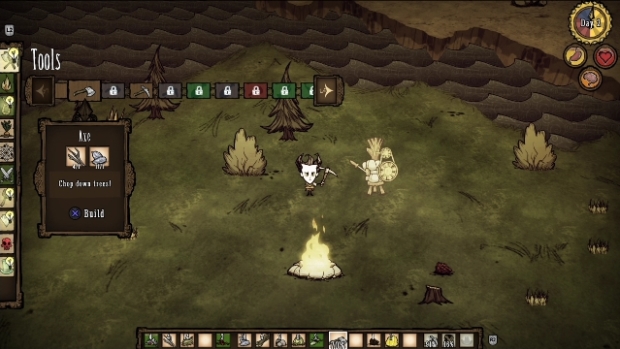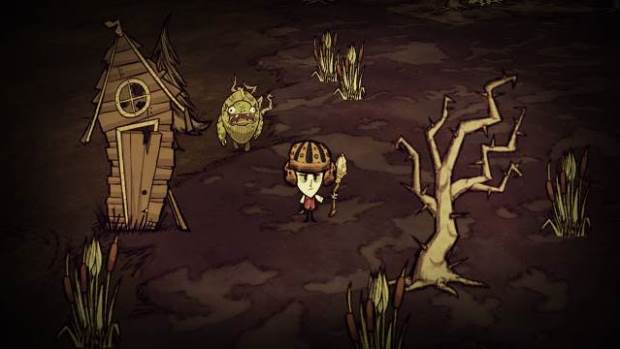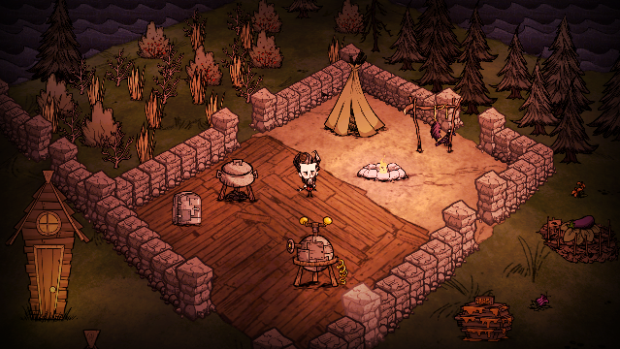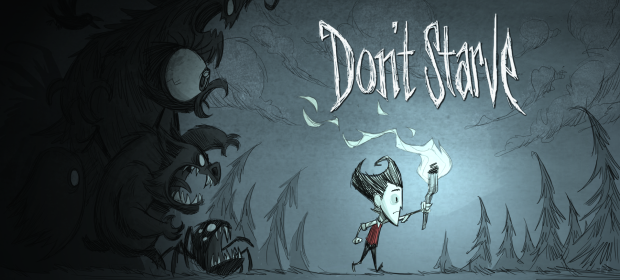If you ever find yourself mysteriously whisked away to a strange, dark land full of forests and rockland and endless trees, possibly ruled over by a sinister fellow named Maxwell, and are forced to make tools from twigs and flint and desperately keep a fire burning to stave off the unseen terrors of the night, always try to keep one thing at the very forefront of your mind: stay the hell away from the frogs.
The psychotic amphibians in Klei’s survival adventure, Don’t Starve (previously released on PC last year), may not be the most dangerous things you’ll encounter, but they’re deceptively innocent looking. You won’t know you’re dead until you find yourself surrounded by the ribbiting little mentalists.
I use frogs as an example because they’re indicative of Don’t Starve as a whole. It’s a game mostly about trial & error, about finding out something is poisonous by licking it; about finding out something has teeth by sticking your hand in its mouth. It’s a game with the same punishing “die & learn” ethos as From Software’s Dark Souls, except there are no cushy bonfires here to save your progress at. Die in Don’t Starve and you’re done, straight back to the start with nothing to show for it but experience.

Initially you are cast as Wilson, an Ace Ventura-haired scientist given the secret to ultimate knowledge by a mysterious malefactor named Maxwell. The secret turns out to be the blueprint to some infernal machine that zaps Wilson into a parallel world with nothing but the clothes on his back and the ability to grow a rather magnificent beard. You’ll be told, quite succinctly, to find some food before nightfall and then you’re left to your own devices. Literally, that’s all the tutorial you get. There’s not even a manual or a How to Play screen.
Similarly to Minecraft or Terraria, you’ll begin by scavenging every resource you can see. This usually includes berries, carrots, grass, saplings and flint. Pretty soon you can make an axe out of the latter two, then a pick-axe to go with it. From then you can chop down trees for logs (and scavenge pine cones to replenish the greenery) and smash boulders for smaller rocks to make yourself a fire pit. Everything you can eat can be cooked, and every living thing you see can be killed for some kind of resource. Nothing is useless in Don’t Starve.
You’ll spend your first few days, and your first hour of play, working out what the hell everything does. You can make traps to catch rabbits and birds, weave a garland of flowers, cobble together a spear and some rudimentary armour to defend yourself. You can make a fishing rod for a little light relief (but avoid the damn frogs!), or go mining gold to build a science machine that will help you make more advanced items like wooden walls, crock pots and mini farms to grow your own food. The aim of the game, every time, is simply to survive as long as you can. It sounds straightforward enough, when in fact it is anything but.

You see, Don’t Starve wants you to die. Days only last a few minutes, and the night brings hidden horrors that will kill you in seconds if you don’t have a light source. Killer hounds, walking trees, scuttling spiders or carnivorous “eye-plants” are deadly enough in the daytime, but if you get stuck outside at night with no light, you’re going to die, it’s that simple. You can be killed by creatures, you can be killed by fire, or you can be killed by the elements (eventually, winter will set in and the nights will become deathly cold) – there isn’t much in Don’t Starve that doesn’t kill you. Thankfully, every death will earn you experience based on your longevity, which will unlock other characters such as a pyromaniac named Willow, a snooty librarian called Wickerbottom, and Wendy, who’s haunted by the ghost of her dead twin. There’s also a handy Morgue, where you can view the bare-bones stats of your previous attempts.
On top of the basic survival, you have three stats to manage. Health is obvious: it’s your physical wellbeing and is only affected by bodily harm or eating poisonous food. Unfortunately, it is very hard to fill it back up without the right ingredients. Then there’s your hunger, which is fairly self-explanatory. If your hunger drops too low, you’ll starve, and not starving is the name of the game. Lastly you have a sanity meter, which is just as essential to maintain. Certain things will send you doolally: using the slightly disgusting “worm holes” to fast travel isn’t good for your state of mind, and neither is murdering too many cute furry animals. Eating the flesh of monsters will affect you, and spending too much time out in the dark won’t help either.
Ultimately, there is always something to consider in Don’t Starve. It’s not a casual game; it’s not the sort of thing you can throw on for five minutes or even mess around in, not if you want to get anywhere. Complacency is a killer, and the absolute aversion to handholding or signposting of any kind means some will find it outright impenetrable to begin with. And yet it’s a lot of fun. There’s a macabre sense of humour in everything, from the Tim Burton-inspired visuals to the dry dialogue (nothing is spoken throughout), and everything is just a little bit sinister. Starting forest fires, spelunking and murdering rabbits are all acceptable pastimes, and after a few deaths you will find a rhythm that sees you advancing faster and faster until you’re literally installing carpets in your camp by Day 10.

Because the world is procedurally generated each time, the mix of wildlife, land types and elements varies – which means your available resources vary, too. As a result, one game can differ from another in very extreme ways, to the point where you might thrive happily until a frog-based accident on Day 22 in one run, only to starve to death trying to live on seeds by Day 8 in another. Sometimes it feels unfair, it’s always punishing and there’s a definite sense that the entire game is callously mocking your pathetic attempts to extend your existence in Maxwell’s weird world – but you’ll keep coming back anyway. There’s even an Adventure Mode hidden inside Survival Mode that shakes things up and breaks any fatigue that may arise due to your constant failures, which is nice.
VERDICT: We expected big things from the studio behind Mark of the Ninja and Shank, and in Don’t Starve, we got them. It’s a wonderfully dark survival-craft game with great scope for emergent, unique experiences, even if it will make you rage occasionally. The UI betrays the PC roots and can be a little hard to use on a smaller TV, and there are those who will find Don’t Starve just too mean-spirited to fully appreciate, but as an intentionally unforgiving survival sim with a sinister twist, it absolutely excels. Even if you can’t grab it while it’s free on PS+, it’s totally worth the £11.99 price tag.

SUPERB. This is the mark of greatness, only awarded to games that engage us from start to finish. Titles that score 9/10 will have very few problems or negative issues, and will deliver high quality and value for money across all aspects of their design.






